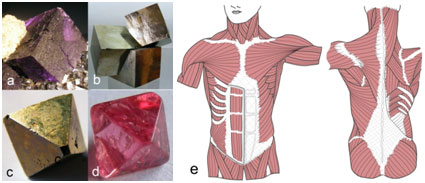The Shape of Nature
The shape of nature by Graham Scarr
The natural world is full of shapes, from the smallest of crystals to the highest of mountains, and from simple molecular helixes to the complex spiralling of muscles and fascial sheets in the human body (Figure 1). Natural patterns and shapes have been generating wonder since at least the time of the ancient Greeks and caused much speculation in relation to living organisms, but most explanations have been (unfairly) relegated to the realm of the esoteric and fanciful.
Figure 1 Crystals and complex biological structures. a) fluorite; b,c) iron pyrite; d) spinel; e) partial spirals of muscles and fascia in the human body. Figures b-e reproduced from Scarr 2014 Handspring.
Modern anatomy has taken many centuries to accumulate a body of knowledge that is now unrivalled in any other sphere. It has classified structures according to the thinking of the day and sought to understand their functions using the latest technologies, but established conventions have allowed many inconsistencies to survive long past their sell by dates. Orthodox views of human movement, for example, are based on the mechanics of man-made machines described in the seventeenth century and have remained essentially unchanged ever since; but biology is not constrained by the rules of classical mechanics and there is now a better way of looking at functional anatomy.
Whenever nature uses the same principle in a variety of different situations there is probably an underlying energetic advantage to its appearance, and biological development and evolution will automatically favour those patterns and shapes that are the most efficient in terms of stability, materials and mass. Even though they can appear to be rather complicated, at the most basic level all structures are the result of interactions between atomic forces, and the orderly arrangements that they settle into are governed by some basic rules of physics. Essentially, it is the fundamental and inter-related principles of geodesic geometry, close-packing and minimal-energy that lead to the formation of crystals and molecules, which thus become the physical representations of the invisible forces within them.
Nature always does things in the simplest and most efficient way possible and a proper understanding of this simplicity now provides a powerful means to relate complex patterns and shapes with functional anatomy. Albert Einstein emphasized that the laws of physics must be the same in every place, which means that even the most complex organism can be understood in terms of the same basic rules of construction. So, by simplifying these inter-atomic forces into those that attract and those that repel, and applying the principles described above, we now have a simple means to understand biological complexity at every size scale.
Biotensegrity
Biotensegrity is a structural design principle in biology that describes a relationship between every part of an organism and the mechanical system that integrates them into a complete functional unit. It is a conceptual model that is causing a paradigm shift in biomechanical thinking and changing the way that we think about functional anatomy. Biotensegrity recognizes that the forces of attraction and repulsion at the molecular scale are comparable with those of tension and compression at higher size scales, and are easily modelled using cables and struts, respectively (figure 2). It is a simple re-evaluation of anatomy as a network of structures under tension and others that are compressed; parts that pull things together and others that keep them apart; basic physics!
Figure 2 A tensegrity structure consisting of compressed struts ‘floating’ within a network of tensioned cables. Reproduced from Scarr 2014 Handspring.
Tensegrity configurations are similar to biological structures in that they are strong, light in weight and resilient to the effects of damaging forces, yet can change shape with the minimum of effort and return automatically to the same position of stable equilibrium. Their structural mechanics operate the same in any position, irrespective of the direction of gravity, and they have similar non-linear visco-elastic type properties that influence movement. Each component part can be constructed from smaller ones within a hierarchy, with each level related to all the others so that the entire structure becomes united into a single functioning unit.
The recognition of biotensegrity as a unifying structural principle in living organisms began in the mid 1970’s with Stephen Levin (b. 1932), an orthopaedic surgeon who observed things at the operating table that could not be explained through orthodox biomechanical theory. He found that tightening up certain ligaments in the knee etc caused the bones to move apart, and that normal bones always had a slight spacing between them, but there was no known mechanism that could make this space possible; it was like the bones were ‘floating’ in the soft tissues. Further research then uncovered a relatively little known structural principle called ‘tensegrity’ and a likely explanation for these findings.
The term ‘tensegrity’ is a combination of the words tension and integrity and this structural system was first recognized in 1948 by Kenneth Snelson (b. 1927), a young sculptor who continues to produce impressive works that he describes as “…unveil[ing] the exquisite beauty of structure itself”. Tensegrity structures are particularly interesting because the struts remain isolated and do not compress each other at any point because they are suspended within the tension network. The architect Buckminster Fuller (1895-1983) recognized them as part of his theory of synergetics, the study of nature’s coordinate system that considers that all natural structures are inherent displays of the forces within them; and Donald Ingber, a cell biologist, has described the structural lattice (cytoskeleton) within cells as a tensegrity structure that regulates cell function. Mechanical engineers also appreciate the distinctive properties of tensegrity structures and are producing robots for use in the exploration of space etc. Both biologists and engineers now recognize that the simple principles of tensegrity can be applied to understanding the behaviour of more complex structures, but because certain aspects are not transferable, Stephen Levin introduced the term biotensegrity to distinguish between these two fields.
Biotensegrity models emulate biology in ways that were inconceivable in the past but it has taken some time for the concept to become widely accepted because of its challenges to generally accepted wisdom. Biotensegrity explains how ‘joints’ can remain completely stable without overstressing the soft tissues surrounding them and demonstrates that the spine is essentially a tensioned structure that can function the same in any position, and how movement is controlled by the very structure itself. It is attracting the attention of biologists and hands-on therapists because it provides a better means to visualize the mechanics of the body in the light of new understandings about functional anatomy.
A biotensegrity view of life sweeps away the man-made constraints of classical mechanics and re-establishes biology at its very core. It is based on the laws of physics first, rather than the artificially contrived ones that have dominated biomechanics for centuries, and recognizes that the structure and behaviour of each molecule, cell, tissue and organism must result from those same rules. Both simple molecules and complex structures result from the interactions of pure energy (forces), and although particular configurations dominate, they are not especially chosen by nature but because their simplicity, efficiency and stability favours them. The real beauty of nature is that it does so much with so little.
Graham Scarr is a chartered biologist and osteopath, and has been researching the significance of natural patterns and shapes over many years. He has also developed new models that progress our understanding of the structure-function relationship in human biology and published several papers on this subject in peer-reviewed scientific journals. His fully illustrated book entitled ‘Biotensegrity: the structural basis of life’ now brings all these findings together for the first time. http://www.tensegrityinbiology.co.uk/
References
Fuller, RB. 1975 Synergetics: explorations in the geometry of thinking. Macmillan.
Heartney, E. 2009 Kenneth Snelson: forces made visible. Hard Press Editions.
Ingber, DE. 1998 The architecture of life. Scientific American (Jan), pp. 30-39.
Levin, SM. www.biotensegrity.com
Scarr, G. 2014 Biotensegrity: the structural basis of life. Handspring Publishing.
Original appearance in the e-magazine Bare essentials 2014 issue 37 http://bareessentialsmagazine.uberflip.com/i/437027/88


